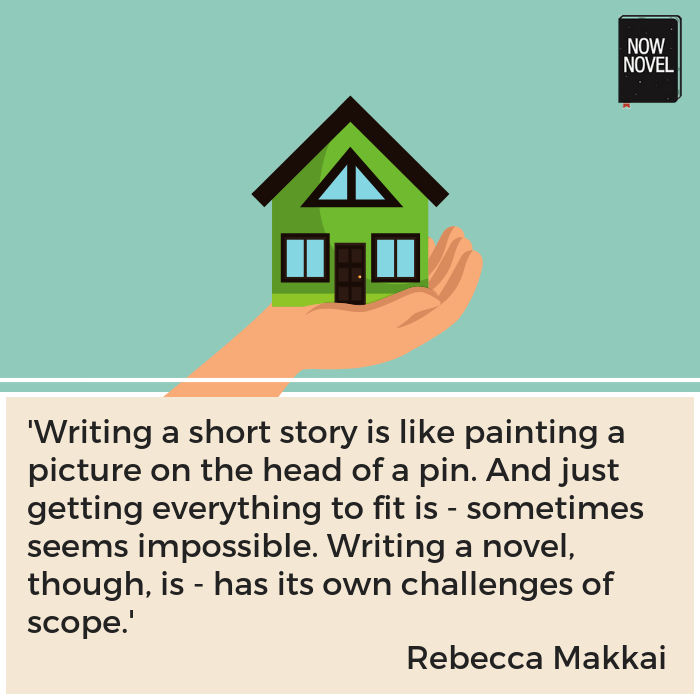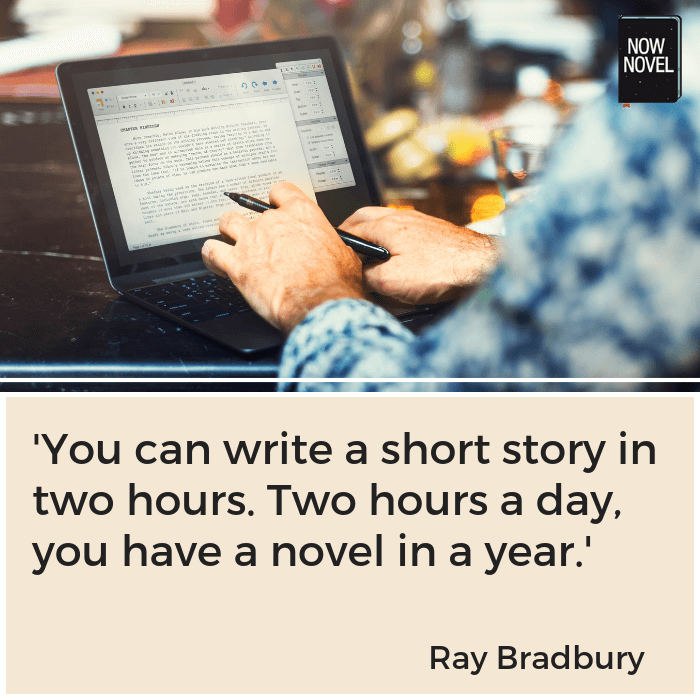The short story has a long and rich tradition, spanning everything from the Gothic tales of Poe to contemporary masterpieces. Writing a short story will improve your writing skills, as you can apply many of the techniques you master in the process to longer forms. Telling a complete story in 5,000 words rather than 100,000 nurtures your storytelling abilities because you:
1. Learn how to create good form and structure
A short story has many of a novel's features. It typically has:
- Exposition (introducing characters, their world, a scenario)
- Development (developing these elements)
- Rising and falling action
- Themes
- Structure
The last point makes writing short stories particularly useful for bettering your craft. Creating a satisfying shape of rising and falling action, well-paced high and low points, is trickier for longer forms. When you write in a smaller form you can see the broader sweep of events and moments from scene to scene easier.
Many famous authors have written now-celebrated works first in trial runs as shorter stories. James Joyce's modernist classic A Portrait of the Artist as a Young Man (1916) was based in part on a shorter autobiographical book, Stephen Hero. This book gave a testing ground for ideas and the structure of events that take place in the last third of Portrait.
2. Play with plot devices in shorter fiction
Plotting a substantial story like a novel is challenging. [The Now Novel story dashboard makes plotting easier using step-by-step prompts and explaining concepts].
Seeing writing short stories as preparatory work for a novel can be useful. Given the shorter time commitment, you can play with plot devices such as starting in the middle of action (in medias res).
A plot device is an incident or anything else that changes the direction of a story or helps to moves it forward. When you write a short story, try use different devices such as:
- Plot twists and reveals (surprising turns of events the reader doesn't see coming)
- Multiple time-frames or versions (you could tell each quarter of a story from one of four siblings' points of view, for example)
- Flashbacks (characters recalling earlier events) or flash forwards
A plot twist, for example, is a good plot device to practice in short story form. Why? Because if executed clumsily or obviously, a twist can frustrate or annoy readers.
The nineteenth century writers Guy de Maupassant and O. Henry were masters of creating concise, effective plot twists. In much of their short fiction, information introduced at the end of the story changes the reader’s understanding of what came before. Modern masters of this device include Ian McEwan and Kazuo Ishiguro.
Learn which plot devices could help make your novel memorable and intriguing by testing them out in short fiction first.

3. Kill your darlings with less time lost
When you've poured your heart into a dense, lengthy novel, it's hard sometimes to cut large swathes that aren't working. The beauty of writing a short story is that you can test and expand character ideas a little more. This helps you see early who you'll fall in love with as you write, and who'll yield narrative dead ends.
The phrase 'kill your darlings', often attributed to Faulkner, means to let go of parts of your story you may be holding onto for sentimental reasons while they don't completely serve your story. It's the clever pun or the sarcastic back and forth that might not actually be contributing enough development or focus, for example.
Writing a short story is a good exercise for cutting away the fat and making every detail of your fiction lean and precise. While a novel is often forgiving of digressions, every moment in a short story has to push the story forward, given the limited space. You have to grab readers' attention and entertain, move, thrill or terrify them, faster. Writing short fiction will help you master this ability to ruthlessly eliminate filler or fluff.
4. Practice concise character development
Often first-time (or even experienced) novelists are tempted to develop characters using long flashbacks and back story. These sometimes take too much focus away from the main narrative arc, from what's happening to characters now.
In a short story, you have to set up characters and convey their distinct personalities fast, using key details. For example, you might sketch a character quickly in a few lines, based on how they are dressed or how they respond to a brief conflict. Concise dialogue also is necessary to just give enough of the voice to show.
Writing short stories helps you to focus on characters' immediate goals, by bringing them closer in terms of the number of pages you have to help (or hinder) their reaching them!
5. Learn how to write lean dialogue
In a novel, you have the opportunity to develop the voices of different characters over a much broader canvas.
In a short story, you need to give those characters distinctive voices within a fraction of the space. Depending on the nature of your story, there might be little dialogue. Yet what little there is has to be focused so you don't waste the short story's limited space.
Read tips on whittling down your dialogue to essentials here.
6. Develop key themes you want to use in a novel
The novel Flowers for Algernon (1959) by Daniel Keyes began life as a short story by the same name. It began with the same themes.
In a short story, you can begin mulling over major themes that you will explore at greater length when you write your novel. Use the condensed medium to sketch out the basics of your characters and plot. It will result in a more tightly structured novel.

7. Refine your writing style, line by line
There is a reason that when a poet turns to writing fiction, critics will often comment on the writer’s command of language. Like poetry, short stories give you the opportunity to work on your prose at a very precise, miniature level. If a story is just a few thousand words long, you have time to pore over every word. It's also why most successful novelists working in longer forms rely on help from skilled editors when they're finished their drafts!
Try writing a few short stories and giving extra attention to the construction of every sentence.Ask questions such as, 'Could this verb here be more active as a participle?' (an '-ing' word).
8. Practice point of view
Point of view is a tricky aspect of narration to master. Many aspiring writers understand the difference between first, second and third person.
In omniscient point of view, a narrator who has access to the thoughts and actions of all characters is telling the story.
In third person limited, the narrative may jump between characters’ heads, but at any given time the narrator can only report what the viewpoint (currently narrating) character sees and knows.
Second person point of view is like a 'choose your own adventure' book, as the narrator addresses the reader as 'you'. ('You lift the gun and check the safety mechanism is active.')
The real problem with point of view tends to come with switching between characters' POVs. When you write a short story, try changing the point of view throughout the entire story as an exercise. Change it from first to third, or vice versa. How does it change the effect? Writing short lets you experiment and be free with your style. Then write that epic novel.
Whether you're writing something short or longer, brainstorm and outline the easy way using Now Novel's step-by-step prompts.









Excellent article. Sharp advices direct to the point.
Enriquillo Rodriguez Amiama - About 9 years ago
Thank you, Enriquillo! I'm glad you enjoyed reading.
Bridget At Now Novel - About 9 years ago
You are welcome Bridget! Pardon the big delay to reply. Thanks for your kind reply! Follow me at Twitter for sharing more, my account is @enriquillo2
Enriquillo Rodriguez Amiama - Over 8 years ago
Thanks for the post.I had started with novel writing but I am convinced writing short stories first would have trained me for novel writing. Now i'm trying my hands at short story writing.
Ohita Afeisume - Almost 9 years ago
There are many sections of writing like the short story, novel, drama, comedy, poem etc. But in our educational institution, we just learn other things like the essay, term paper writing, research paper writing and so on. So, students are bored with writing. When their teachers asked them to write then they say other that please write my term paper, research paper etc. But this kind of writings never helps us to write literature.So, I think, short story writing should be included in the syllabus. If we notice the famous writers' childhood. Then we can notice that they had started their career by writing the small stories. Because it is the basic steps to understand the format of literature. It teaches us how we should create a character, how we maintain the flow of events and other important issues. So, it might help us to improve our writing skills.Thank you.
Bert M. Davis - About 8 years ago
That's a very good point, Bert. It most likely varies from district to district or country to country, but in SA we do have creative writing as part of the English syllabus in schools.
Bridget At Now Novel - About 8 years ago
Its good that you are writing a short story. Writing an short story would give you an idea of how the writers complete it without any problems. You must read pro essay reviews so that you can learn how you can complete your short story writing and this would give you an opportunity to start your own writing business.
Justin P. Simon - Almost 8 years ago
So many useful tips, thanks!
Courtney Benard - About 6 years ago
It's a pleasure, Courtney! Thanks for reading.
Jordan At Now Novel - About 6 years ago
Playing with plot devices was a great tip for me. I need to stop being scared and just write the landscaping short story I've been meaning to. Thank you.
Wendy Shaw - About 4 years ago
Hi Wendy, completely agree - write the story you're missing, and write it for you :) Thank you for reading our articles and for sharing your thoughts.
Jordan - About 4 years ago